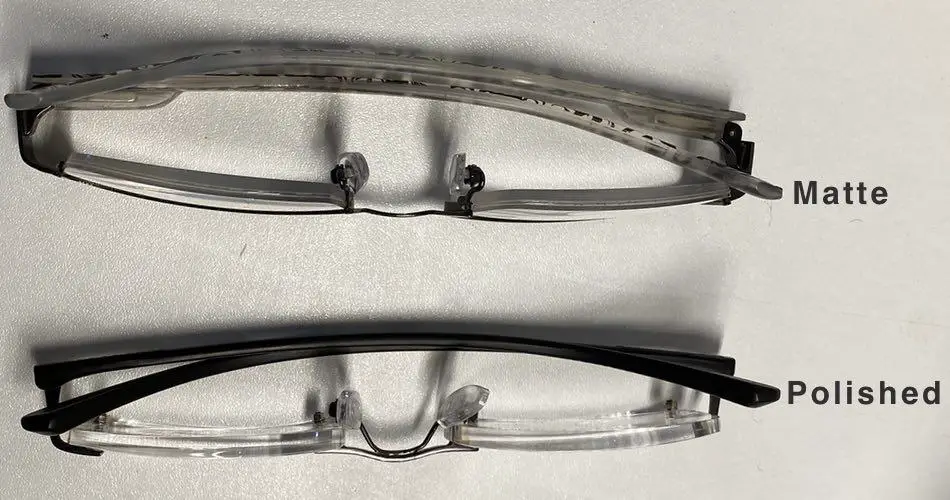In this article, you will learn about the benefits and drawbacks of polished or matte lens edges. The decision whether polished or matte lens edges are right for you is highly individual when it comes to aesthetics. Depending on where you work and live you will notice the drawbacks of polished lens edges more or not at all.
For example, when you bought a rimless or partly rimless frame a lot of times a polished lens edge will make the edge of the lenses appear a little more aesthetically pleasing. Due to the transparent look, the polished sides will fit the polished front and back of the lenses more. Some say the lenses look slightly thinner when high prescriptions are needed.
The big drawback of polished lens edges is increased reflectance depending on where the light source can be found. For example, when a lamp is hanging pretty much on top of the head of the wearer the light shines directly into the polished material of the lens. In comparison to the front and back surface, the lens edges will have an anti-reflective coating.
So when the light enters the lens from the side it will be reflected more compared to a matte finish. Some people which are especially light-sensitive find this disturbing because they can perceive increased glare with the polished lens edges.
Here in the picture below you can see a higher prescription lens with polished and matte lens edges. The bigger the surface which is polished from the sides the more drawbacks the wearer could notice. In the next paragraphs, you will see several examples of lenses when I would recommend polishing the lens edges and when to avoid it.
When the frame hinders light rays to enter the lens from above the drawbacks can be minimized. This is true for nylon-style frames. When rimless frames are chosen the drawbacks of a polished lens edge appear more dominant.

Polish or Not to Polish Plus Lenses?
Plus lenses are usually thinner temporal and thicker at the part where your nose is located. So from the sides, this usually makes not much of a difference in regards to aesthetics. Compared to the thinner temporal sides usually, the top and bottom are thicker and therefore provide more surface for the light rays to enter the lens when polished.
When you already had polished lens edges and you did not notice glare or disturbing reflections then you will be good to go with polished lens edges again. But when you had a matte finish on the lens edges and you have a workspace with lamps directly above you I would not recommend polished lens edges.
Polish or Matte Lens Edges? Which Is the Correct Choice for minus Lenses?
Minus lenses are generally thinner on top and in the lower half of the lenses and have in most cases their thickest parts positioned temporally. In such a case the light rays have less surface on the edge of the lenses to enter and even if you have some lamps placed above you at your workspace glare probably will not be an issue.
When you look from the side on lenses with polished edges compared to lenses with a matte finish most people will find the polished one more aesthetically pleasing. However, I recommend always present the two options before the glasses are made.
In case you have one of the options and you do not like it your optician has the option to produce a matte or polished finish on the lens edges in a few minutes. In the last paragraphs, I will explain how to polish the edges of the glasses’ lenses.
How Do You Polish the Edges of Glasses Lenses?
In order to polish the matte lens edges of glasses, a few tools are needed to achieve perfect high gloss effects. The optician does this polishing of the edges with a CNC machine or a polishing machine. When the lens edges need a glossy finish when new glasses are made oftentimes the CNC machine has an option for this and the polishing is done in a couple of seconds after the lenses got ground to their final shape.
When the lenses are already built into the frame and you wish to get the polished lens edges afterward the optician needs to take the lenses out of the frame and use the polishing machine. Therefore the optician has various polishing wheels to achieve different polishing finishes.
This polishing wheel rotates quickly and when the lens edges are pressed against the rotating polishing for a couple of seconds the edges start to get the desired glossy effect. During the polishing, process heat gets produced.
The coatings of the lens need to withstand the heat. In some cases, the coating could be damaged when the optician presses the lens for too long against the polishing wheel. This is why it is crucial to minimize the time and pressure during the polishing to achieve the polish finish with the least heat applied possible.
Damage from the polishing process can be seen by slightly changed colors in regards to the reflections of the coating or by little cracks in the coating. In such a case the lenses need to be replaced.
